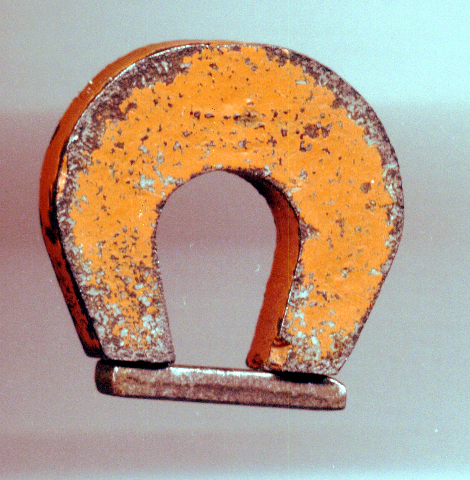Magnet Keeper on:
[Wikipedia]
[Google]
[Amazon]
 A magnet keeper, also known historically as an armature, is a bar made from magnetically soft iron or steel, which is placed across the poles of a
A magnet keeper, also known historically as an armature, is a bar made from magnetically soft iron or steel, which is placed across the poles of a
 A magnet keeper, also known historically as an armature, is a bar made from magnetically soft iron or steel, which is placed across the poles of a
A magnet keeper, also known historically as an armature, is a bar made from magnetically soft iron or steel, which is placed across the poles of a permanent magnet
A magnet is a material or object that produces a magnetic field. This magnetic field is invisible but is responsible for the most notable property of a magnet: a force that pulls on other ferromagnetic materials, such as iron, steel, nickel, c ...
to help preserve the strength of the magnet by completing the magnetic circuit
A magnetic circuit is made up of one or more closed loop paths containing a magnetic flux. The flux is usually generated by permanent magnets or electromagnets and confined to the path by magnetic cores consisting of ferromagnetic materials lik ...
; it is important for magnets that have low magnetic coercivity
Coercivity, also called the magnetic coercivity, coercive field or coercive force, is a measure of the ability of a ferromagnetic material to withstand an external magnetic field without becoming Magnetization, demagnetized. Coercivity is usual ...
, such as alnico magnets (0.07T).
Keepers also have a useful safety function, as they stop external metal being attracted to the magnet. Many magnets do not need a keeper, such as neodymium magnet
A nickel-plated neodymium magnet on a bracket from a hard disk drive
file:Nd-magnet.jpg">Nickel-plated neodymium magnet cubes
Left: high-resolution transmission electron microscopy image of Nd2Fe14B; right: crystal structure with unit cell mar ...
s, as they have very high coercivities; only those with lower coercivities, meaning that they are more susceptible to stray fields, require keepers.
A magnet can be considered as the sum of many small magnetic domains, which may be only a few microns or smaller in size. Each domain carries its own small magnetic field, which can point in any direction. When all the domains are pointing in the same direction, the fields add up, yielding a strong magnet. When these all point in random directions, they cancel each other, and the net magnetic field is zero.
In magnets with lower coercivities, the direction in which the magnetic domains are pointing is easily swayed by external fields, such as the Earth's magnetic field
Earth's magnetic field, also known as the geomagnetic field, is the magnetic field that extends from structure of Earth, Earth's interior out into space, where it interacts with the solar wind, a stream of charged particles emanating from ...
or perhaps by the stray fields caused by flowing currents in a nearby electrical circuit. Given enough time, such magnets may find their domains randomly oriented, and hence their net magnetization greatly weakened. A keeper for low-coercivity magnets is just a strong permanent magnet that keeps all the domains pointing the same way and realigns those that may have gone astray.
References
Magnetism {{electromagnetism-stub